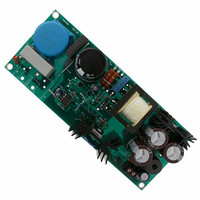NCP1203GEVB ON Semiconductor, NCP1203GEVB Datasheet - Page 7

NCP1203GEVB
Manufacturer Part Number
NCP1203GEVB
Description
EVAL BOARD FOR NCP1203G
Manufacturer
ON Semiconductor
Specifications of NCP1203GEVB
Design Resources
NCP1203GEVB BOM NCP1203GEVB Gerber Files NCP1203 EVB Schematic
Main Purpose
AC/DC, Primary Side
Outputs And Type
1, Isolated
Voltage - Output
19V
Current - Output
4A
Voltage - Input
85 ~ 230VAC
Regulator Topology
Flyback
Frequency - Switching
60kHz
Board Type
Fully Populated
Utilized Ic / Part
NPC1200
Lead Free Status / RoHS Status
Lead free / RoHS Compliant
Power - Output
-
Lead Free Status / Rohs Status
Lead free / RoHS Compliant
For Use With/related Products
NCP1203G
Other names
NCP1203GEVBOS
INTRODUCTION
architecture where the switch−off time is dictated by the
peak current setpoint. This component represents the ideal
candidate where low part−count is the key parameter,
particularly in low−cost AC−DC adapters, auxiliary
supplies etc. Due to its high−performance High−Voltage
technology, the NCP1200 incorporates all the necessary
components normally needed in UC384X based supplies:
timing components, feedback devices, low−pass filter and
self−supply. This later point emphasizes the fact that ON
Semiconductor’s NCP1200 does NOT need an auxiliary
winding to operate: the product is naturally supplied from
the high−voltage rail and delivers a V
system is called the Dynamic Self−Supply (DSS).
consumption and the MOSFET’s gate charge, Qg. If we
select a MOSFET like the MTD1N60E, Qg equals 11 nC
(max). With a maximum switching frequency of 48 kHz (for
the P40 version), the average power necessary to drive the
MOSFET (excluding the driver efficiency and neglecting
various voltage drops) is:
Fsw = maximum switching frequency
Qg = MOSFET’s gate charge
V
consumption, simply divide this result by V
at no−load will therefore heavily rely on the internal IC
consumption plus the above driving current (altered by the
driver’s efficiency). Suppose that the IC is supplied from a
400 V DC line. To fully supply the integrated circuit, let’s
imagine the 4 mA source is ON during 8 ms and OFF during
50 ms. The IC power contribution is therefore: 400 V . 4 mA
Fsw @ Qg @ V
Fsw @ Qg
CC
The NCP1200 implements a standard current mode
The DSS behavior actually depends on the internal IC
To obtain the final driver contribution to the IC
= V
GS
= 530 mA. The total standby power consumption
level applied to the gate
cc
with
10.6 V Avg.
10.00M
CC
Figure 15. The Charge/Discharge Cycle
to the IC. This
APPLICATIONS INFORMATION
CC
V
CCOFF
Over a 10 mF V
: Idriver =
30.00M
http://onsemi.com
ON
= 11.4 V
50.00M
7
CC
Output Pulses
Dynamic Self−Supply
V
can easily describe the current source operation with a bunch
of simple logical equations:
is ON, no output pulses
OFF, output is pulsing
ON, output is pulsing
sketch offers the necessary light:
. 0.16 = 256 mW. If for design reasons this contribution is
still too high, several solutions exist to diminish it:
V
CC
CCON
Capacitor
The DSS principle is based on the charge/discharge of the
POWER−ON: IF V
IF V
IF V
Typical values are: V
To better understand the operational principle, Figure 15’s
Filter
EMI
1. Use a MOSFET with lower gate charge Qg
2. Connect pin through a diode (1N4007 typically) to
Figure 16. A simple diode naturally reduces the
70.00M
bulk capacitor from a low level up to a higher level. We
one of the mains input. The average value on pin 8
becomes
example drops to: 160 mW.
CC
CC
= 9.8 V
OFF
increasing < V
decreasing > V
90.00M
2 * V mains PEAK
average voltage on pin 8
CC
4.7 mF
400 V
CCOFF
p
V
Current
Source
< V
CC
C3
CCOFF
CCON
CCOFF
= 11.4 V, V
+
THEN Current Source is
THEN Current Source is
. Our power contribution
THEN Current Source
1
2
3
4
NCP1200
Adj
FB
CS
GND Drv
CCON
1N4007
Dstart
V
NC
HV
CC
= 9.8 V
8
7
6
5










